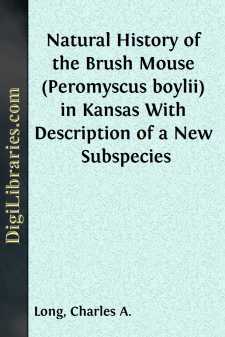Categories
- Antiques & Collectibles 13
- Architecture 36
- Art 48
- Bibles 22
- Biography & Autobiography 813
- Body, Mind & Spirit 142
- Business & Economics 28
- Children's Books 17
- Children's Fiction 14
- Computers 4
- Cooking 94
- Crafts & Hobbies 4
- Drama 346
- Education 46
- Family & Relationships 57
- Fiction 11829
- Games 19
- Gardening 17
- Health & Fitness 34
- History 1377
- House & Home 1
- Humor 147
- Juvenile Fiction 1873
- Juvenile Nonfiction 202
- Language Arts & Disciplines 88
- Law 16
- Literary Collections 686
- Literary Criticism 179
- Mathematics 13
- Medical 41
- Music 40
- Nature 179
- Non-Classifiable 1768
- Performing Arts 7
- Periodicals 1453
- Philosophy 64
- Photography 2
- Poetry 896
- Political Science 203
- Psychology 42
- Reference 154
- Religion 513
- Science 126
- Self-Help 84
- Social Science 81
- Sports & Recreation 34
- Study Aids 3
- Technology & Engineering 59
- Transportation 23
- Travel 463
- True Crime 29
Natural History of the Brush Mouse (Peromyscus boylii) in Kansas With Description of a New Subspecies
by: Charles A. Long
Description:
Excerpt
In order to determine the geographic distribution of the brush mouse in the state, 15 localities, chosen on the basis of suitable habitat, were investigated by means of snap-trapping in the winter and spring of 1959, spring of 1960, and winter and spring of 1961. Variation in specimens obtained by me and in other specimens in the Museum of Natural History, The University of Kansas, was analyzed. Captive mice from Cherokee County, Kansas, were observed almost daily from March 27, 1960, to June 1, 1961. Captive mice from Chautauqua and Cowley counties were studied briefly. Contents of 38 stomachs of brush mice were analyzed, and diet-preferences of the captive mice were studied. Data from live-trapping and from snap-trapping are combined and provide some knowledge of size and fluctuation of populations in the species.
Examination of the accumulated specimens and the captive mice reveals the occurrence in southern Kansas of an unnamed subspecies, which may be named and described as follows:
Peromyscus boylii cansensisnew subspeciesType.—Male, adult, skin and skull; No. 81830, K. U.; from 4 mi. E Sedan, Chautauqua County, Kansas; obtained on December 30, 1959, by C. A. Long, original No. 456.
Range.—Known from 3 mi. W Cedar Vale, in Cowley County, Kansas, and from the type locality.
Diagnosis.—Size medium (see Table 1 beyond); underparts white; upper parts Ochraceous-Tawny laterally, becoming intermixed with black and approaching Mummy Brown dorsally (capitalized color terms after Ridgway, 1912); eye nonprotuberant; tail short but well-haired distally and usually less than half total length; nasals long; cranium large.
Comparisons.—From P. b. attwateri, the subspecies geographically nearest cansensis, the latter can be easily distinguished by the less protuberant eyes and relatively shorter tail (91 per cent of length of head and body; in topotypes of P. b. attwateri from Kerr County, Texas, 104 per cent; in specimens of P. b. attwateri from Cherokee County, Kansas, 103 per cent). P. b. cansensis is darker than P. b. attwateri and darker than P. b. rowleyi, the palest subspecies of brush mouse, which occurs to the westward. The skull and nasals (see Table 1) in adults of P. b. attwateri from Cherokee County average shorter than in cansensis.
Specimens examined.—Total, 26. Cowley Co.: 3 mi. W Cedar Vale, 16. Chautauqua Co.: type locality, 10.
Table 1. Average and Extreme Measurements of Specimens of P. b. cansensis, of P. b. Attwateri From Cherokee County, Kansas, and of Topotypes of P. b. attwateri Listed by Osgood, 1909.P. b. cansensisP. b. attwateriThree miles westof Cedar ValeType localityBoth localitiesTwo miles south
of GalenaType localityNo. specimens1171810Total length180.5
170-199176.7
166-188179.1
.....186.2
170-210196.0
.....Tail-vertebrae85.5
72-10185.0
75-9385.3
.....94.5
83-104100.0
.....Hind foot23.1
22-2423.6
22-2523.3
.....23.8
22-2521.0
.....Ear from notch18.2
17-1919.1
18-2118.5
.....18.4
14-21.....
.....Greatest length of skull27.9
26.8-29.028.3
27.9-28.928.1
.....27.8
26.6-29.1.....
.....Length of nasals10.4
9.9-10.810.2
9.5-10.710.3
.....9.9
9.1-10.4.....
.....Zygomatic breadth14.3
13.9-15.013.5
13.0-13.913.9
.....13.8
13.3-14.4.....
.....
From Turtle Creek, Kerr County, Texas, after Osgood (1909:148).
Distribution of Peromyscus boylii in KansasThe subspecies Peromyscus boylii attwateri is known in the state only from Cherokee County, the southeasternmost county in the state. Probably the only locality where the brush mouse occurs in that county is on the systems of cliffs along Shoal Creek, southward from Galena, to the eastward of Baxter Springs. This is the extent of the known range, and in my opinion the probable range, of P. b. attwateri in the state (see Fig....


